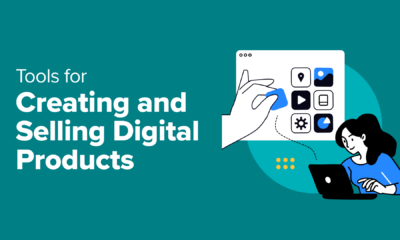SEO
How Digital Video Advertising Will Dominate The Next Decade

Incorporating video into your marketing strategy is now table stakes – in fact, 86% of businesses were using videos for marketing in 2021.
If you’re not using this format to engage customers, your competitors almost certainly are.
There’s a super simple reason video advertising so popular – it just works.
A recent consumer survey shows that 84% have been compelled to buy a product or service after watching a video. The same study found that consumers are more than twice as likely to share video as other types of content, too.
Video advertising can help improve your brand’s online visibility in search results, social media, and around the web.
Are you making good use of the opportunity?
Video & The Contemporary Web
It isn’t your imagination: Browsing the web today is basically like watching an endless set of videos looped together on end.
On all different types of websites – from social platforms, to news organizations, to company pages – digital strategists are employing an astounding amount of video content for their voracious audience to consume at will.
Advertisement
Continue Reading Below
Whether it’s in the form of educational content, reports, entertainment, or ads, organizations have caught on to the fact that high-quality video has the ability to engage users on a deep and substantial level.
The modern web is now driven by video in a way that didn’t seem possible even 15 years ago, thanks largely to the ubiquity of personal mobile devices and omnipresent, reliable high-speed internet connections.
We’ve certainly come a long way from the latter half of the 2000s when the only place to watch videos on the web was some niche site called YouTube.
All you have to do to understand how important video is as a driver of online content in the current era is read the reports detailing how many outlets are shifting vast resources to video production.
Among these are some sites with massive traffic figures, including:
- Buzzfeed.
- Various Time, Inc. properties.
- Conde Nast.
- The New York Times Co.
Advertisement
Continue Reading Below
Snapchat continues to be one of the fastest-growing social media entities largely on the basis of its video stories, and Instagram has had success by introducing a similar feature on its platform.
According to YouTube, users watched over 1 billion hours of video on the site every day.
Whether you open up your laptop, unlock your phone, or fire up your smart TV, there is no escaping video content, so you might as well embrace it.
The Boom In Digital Video Advertising
And that’s where digital video advertising comes into play.
Companies have realized that the reconditioning of consumers to embrace and even expect video at every turn can have many advantages.
Video has become such a natural part of the web browsing experience that advertisers can use it to quickly engage with their audience as if it was content they had sought out specifically.
Well-designed logos and high-quality banner ads can be very effective in spurring interest, but video ads offer organizations an opportunity to connect on a deeper level right from the outset, by establishing a relationship, inviting the audience into the fold, and visually educating them in an effort to curate the buying journey.
This has all led to a glut in digital video advertising spending recently.
Companies from across the spectrum are pouring more resources into engaging users with unique video ad content.
Digital video advertising is a strategy that can work for any type of company: B2B or B2C, enterprise or SMB, high-tech or analog products.
Using Micro Video Ads To Spur Engagement
One trend that’s picking up steam is companies employing short, micro-videos in order to grab a viewer’s attention quickly and leave a big impression.
These are generally only about 10 seconds (or less) in length, and they have mounted an interesting challenge against the long-standing 30-second video format that has been used since television commercials first became a common practice.
The philosophy behind them is driven by the fact that modern digital marketing isn’t often just a single interaction that leads immediately to a purchase; it’s a curated journey that entails a variety of different stages and techniques.
Advertisement
Continue Reading Below
You don’t have to say everything about your product or service in your video ad. You just have to say something interesting enough that it will get the lead viewers to delve more deeply into your ecosystem through your content marketing, email capture, or another tool.
Micro-videos have proven especially useful in engaging Millennial buyers, whose attention spans have been shaped by the internet for most of their lives.
Using micro-videos doesn’t mean, however, that you have to neglect the traditional 30-second video. You should craft your digital video advertising strategy by mixing and matching different length pieces.
Also, keep in mind that micro-videos should be able to connect with the viewer without the aid of sound.
Many people browse on silent mode, and by the time they think about turning the volume on your micro-video will likely have ended.
Social Media & Video Ads: A Match Made In Heaven
It almost seems like kismet for marketers that social media use patterns and video advertising collided with each other on the way to online dominance because they are an outlet and form that really are made for one another.
Advertisement
Continue Reading Below
Facebook users have become accustomed to their feeds being filled with autoplaying videos from various sources.
Instagram and Snapchat users think nothing about spending minutes at a time habitually scrolling through live video stories.
Meanwhile, companies can tailor video ads for these settings that remarkably resemble content from users’ followers.
When your audience is expecting video content from someone they follow, it increases the chances that they’ll engage quickly and then stay for the entire ad.
Social media platforms like Instagram are also great for incorporating user-generated content (more on that later) to erase the barriers between buyer and brand.
You can also dig deeply into Facebook’s demographic data to improve your targeting and personalization abilities and drive more consistent conversions.
If the real power of digital video advertising lies at the intersection of engagement and personalization, then various social media outlets are a natural fit for optimizing it.
Video Advertising Tips & Resources
Looking to enter the world of video advertising or level up your game for the year ahead?
Advertisement
Continue Reading Below
Seek out opportunities to be culturally relevant by tapping into current events and trending topics. Check out these keyword and topic research tips for crafting video in the wake of COVID-19, for example.
If current events doesn’t feel right for your brand, consider nostalgia marketing. It’s a powerful tactic for inducing an emotional response that helps viewers feel an instant connection to your brand.
Check out this analysis of U.K. retailer John Lewis’s and other video ad campaigns to see how it’s done.
Don’t let your budget make video ads seems out of reach. There are all kinds of tools available to help you create visually stunning, compelling videos even on a tight budget. The YouTube Video Builder is just one example.
And if you’re looking for more expert advice to improve your videos and boost ROI, don’t miss these 8 tips for better video ad performance, from Pauline Jakober.
What Else Will Dominate The Next Decade?
If video advertising is the trend that is dominating the landscape today, that must mean that there are other offshoots poised to make a splash in the near future.
Advertisement
Continue Reading Below
What represents the next wave?
- User-generated content: This isn’t necessarily new to the ad world, but companies are getting more creative about finding ways to create ad content that looks like something other than an ad, thereby increasing the effectiveness and prevalence of user-generated content. It works because it gives you something that you don’t have: a real buyer’s experience and perspective, and it allows you to meld that with the marketing voice of your brand.
- Virtual reality: This allows you to immerse the audience in a world of your own creation and gives you the opportunity to shape their experience in the virtual world with astounding depth and complexity.
- Augmented reality: This may not be exactly the same as video advertising, but they share similar DNA, and augmented reality marketing excels at using targeted data to deliver an intensely personalized experience.
We’re already starting to see some of the impacts of these strategies, but wide-scale deployment of tactics such as user-generated content, virtual reality, and augmented reality is still to come.
Conclusion
Digital video advertising spend was estimated to have topped $55 billion in the U.S. alone in 2021, and it shows no signs of slowing down.
In fact, experts predict it will exceed $78.5 billion by the end of 2023.
If video advertising is not yet a part of your marketing strategy, it’s time to act. Video is the preferred method for consumers to receive all kinds of information and messaging – and if you’re not there, your products and services can’t even be considered.
More resources:
Advertisement
Continue Reading Below
Featured Image: Shutterstock/panuwat phimpha



















You must be logged in to post a comment Login